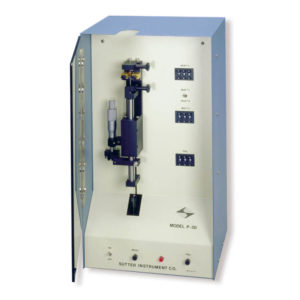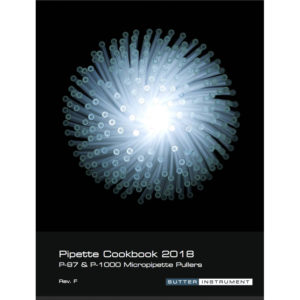The P-77 Puller was Sutter Instrument's founding product, and the first electronic pipette puller on the market. After 40 years of continual development, they've become the undisputed leader in micropipette pullers.
Forming glass micropipettes at a nanoscale demands precision and sophisticated controls. From years of continued refinement of the micropipette puller, Sutter pullers represent the state-of-the-art in micropipette fabrication. From the ease of use of the P-1000 touch screen display to the P-2000, one of the only pullers available that can fabricate pipettes from pure quartz tubing, Sutter's pullers have become the world standard.
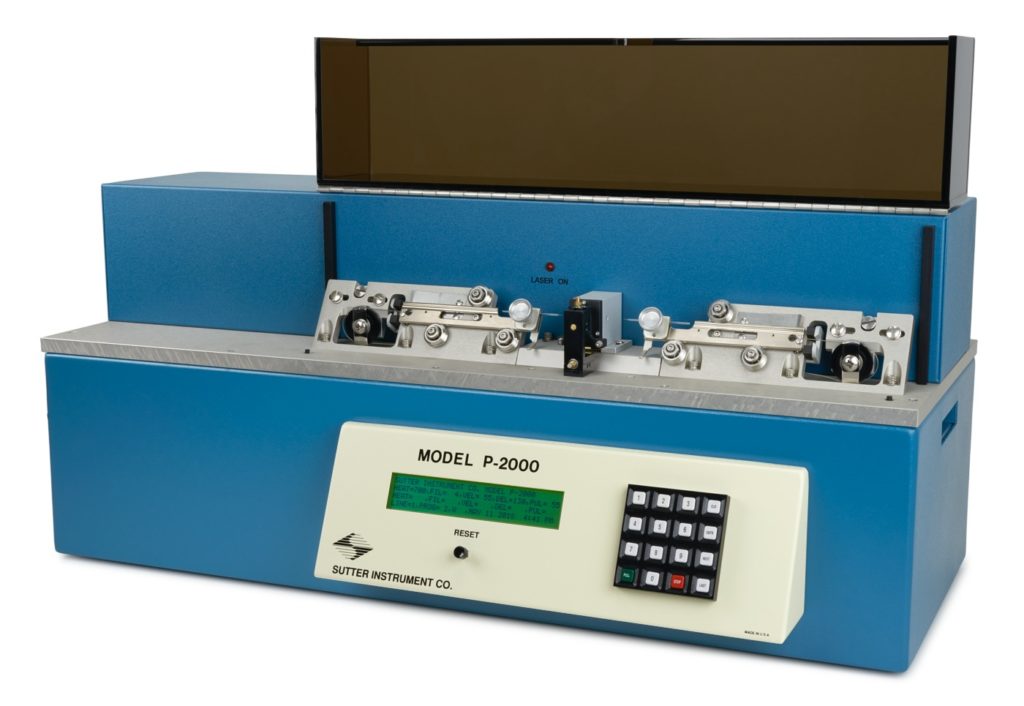
The P-1000 is the latest evolution of the Flaming/Brown™ Style micropipette puller. This puller extends the features of the P-97 by incorporating a color touch screen and integrating new technology that simplifies programming. Unique features such as the safe heat mode, diagnostic testing, line repeat mode and jaw temperature sensor assist in creating the ideal pipette morphology. The pre-installed Sutter Pipette Cookbook, glossary and help topics, make it easy to access the extensive library of programs. Both pullers offer: microprocessor controlled programmability, constant current power supply, a self-contained precision air delivery system, and a patented velocity sensing system. These design elements have lead to significant improvements in pipette reproducibility when compared to other micropipette pullers.
The current state-of-the-art in micropipette puller technology is the P-2000. It incorporates the mechanical design and programmability of the Flaming/Brown pullers, but uses a CO2 laser as the heat source. With the addition of the laser, quartz tubing can now be pulled along with other lower melting point glass compositions. Quartz pipettes have helped eliminate some technical barriers in electrophysiological studies and have enhanced microinjection procedures as well as near field scanning microscopy.
The P-30 is their lowest priced and least sophisticated puller, based upon an NIH design from the 1950s. As a vertical puller, it is intended for basic requisites for a pipette pulling device and provides a few additional features. It is suitable for basic micropipette fabrication, sharp electrode, and microinjection work.
The BV-10 micropipette beveler continues to be the state-of-the-art in micropipette beveling technology. For precision beveling of pipette tip diameters from fractions of a micron to tens of microns, it is the system of choice.
Micropipette Fabrication
Showing all 9 results
-
Micropipette Fabrication
P-1000 Next Generation Micropipette Puller
Developed through years of experience with the Flaming/Brown style micropipette pullers and infused with leading edge technology, Sutter is proud to introduce the P-1000 micropipette puller. The most obvious new feature is the color touchscreen display that provides an intuitive and full-featured interface.
-
Micropipette Fabrication
P-2000 Laser-Based Micropipette Puller
The P-2000 micropipette puller represents a significant advance in the technology of fabrication of micropipettes, optical fiber probes, and nanospray tips. The P-2000 integrates a CO2 laser-based heat source with the technology derived from Sutter’s extensive experience with conventional pullers. This system offers capabilities unmatched by other pullers.
-
Micropipette Fabrication
P-97 Flaming/Brown Micropipette Puller
The P-97 Flaming/Brown type micropipette puller is ideal for fabricating micropipettes, patch pipettes and microinjection needles. While retaining many of the features of earlier models, the P-97 offers improvements in mechanical, electronic and software design.
-
Microinjection, Micropipette Fabrication
BV-10 Microelectrode Beveler
Elegant and simple to use, the BV-10 from Sutter Instrument Co. offers precision beveling of micropipette tips between 0.1 and 100µm. The unique abrasive plate drive system is vibration free for greater control of the beveling process. Beveling can be accomplished very rapidly and produces consistent tip diameters using the techniques as described by Brown and Flaming, Science, August 1974, Vol. 185.
-
Micropipette Fabrication
Filaments and Accessories for Pipette Pullers
Box filaments are recommended for large diameter, double barreled, or aluminosilicate glass. Box filaments are particularly suitable for slice preparations where long, parallel walls would aid penetration. If using a box filament, the size of the square box should be approximately 1.0mm to 1.5mm larger than the outside diameter of the glass that you will be using. For IVF and ICSI applications, a 2.5mm x 4.5mm box filament is recommended. For pronuclear injection work, we recommend a 2.5mm x 2.5mm box filament. Call for more specific advice or to request a combination of settings, filaments, and glass for your application. Trough filaments are excellent general purpose filaments and are recommended for patch pipettes produced from either standard or thin wall glass.
-
Micropipette Fabrication
Glass for Pipette Fabrication
Sutter Instrument Company, in addition to the finest micropipette pullers available, offer a wide selection of high quality capillary glasses in various sizes and materials. Though there are many types and sizes of capillary glass available, Sutter have carefully selected only those that pass their criteria. Their expertise in micropipette technology assures you of precision and high quality.
-
Micropipette Fabrication
P-1000 Next Generation Micropipette Puller
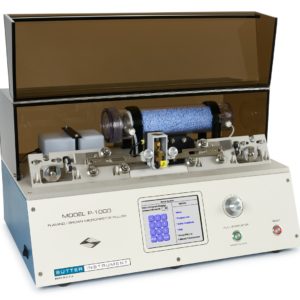
Developed through years of experience with the Flaming/Brown style micropipette pullers and infused with leading edge technology, Sutter is proud to introduce the P-1000 micropipette puller. The most obvious new feature is the color touchscreen display that provides an intuitive and full-featured interface.
SKU: P-1000 -
Micropipette Fabrication
P-2000 Laser-Based Micropipette Puller
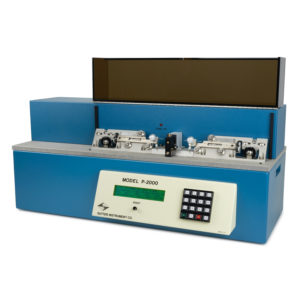
The P-2000 micropipette puller represents a significant advance in the technology of fabrication of micropipettes, optical fiber probes, and nanospray tips. The P-2000 integrates a CO2 laser-based heat source with the technology derived from Sutter’s extensive experience with conventional pullers. This system offers capabilities unmatched by other pullers.
SKU: P-2000 -
Micropipette Fabrication
P-97 Flaming/Brown Micropipette Puller
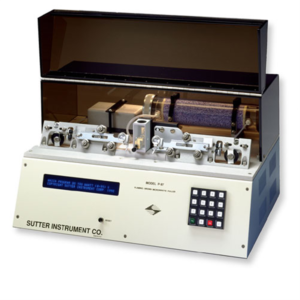
The P-97 Flaming/Brown type micropipette puller is ideal for fabricating micropipettes, patch pipettes and microinjection needles. While retaining many of the features of earlier models, the P-97 offers improvements in mechanical, electronic and software design.
SKU: P-97 -
Micropipette Fabrication
Advanced Micropipette Techniques

In 1973, the authors began a course of systematic studies designed to help them improve the capabilities and efficiency of intracellular research using the micropipette technique. This is essential reading for anyone using micropipettes!
SKU: Book -
Microinjection, Micropipette Fabrication
BV-10 Microelectrode Beveler
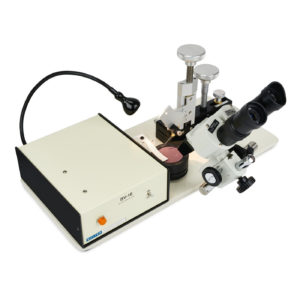
Elegant and simple to use, the BV-10 from Sutter Instrument Co. offers precision beveling of micropipette tips between 0.1 and 100µm. The unique abrasive plate drive system is vibration free for greater control of the beveling process. Beveling can be accomplished very rapidly and produces consistent tip diameters using the techniques as described by Brown and Flaming, Science, August 1974, Vol. 185.
SKU: BV-10 -
Micropipette Fabrication
Filaments and Accessories for Pipette Pullers
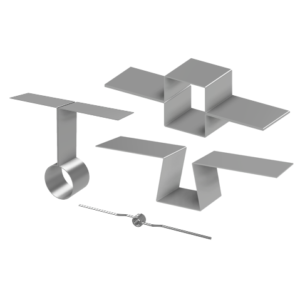
Box filaments are recommended for large diameter, double barreled, or aluminosilicate glass. Box filaments are particularly suitable for slice preparations where long, parallel walls would aid penetration. If using a box filament, the size of the square box should be approximately 1.0mm to 1.5mm larger than the outside diameter of the glass that you will be using. For IVF and ICSI applications, a 2.5mm x 4.5mm box filament is recommended. For pronuclear injection work, we recommend a 2.5mm x 2.5mm box filament. Call for more specific advice or to request a combination of settings, filaments, and glass for your application. Trough filaments are excellent general purpose filaments and are recommended for patch pipettes produced from either standard or thin wall glass.
SKU: Filaments -
Micropipette Fabrication
Glass for Pipette Fabrication
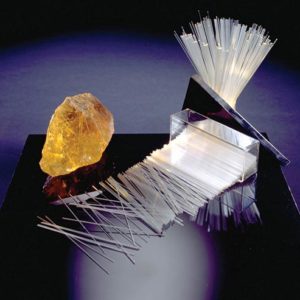
Sutter Instrument Company, in addition to the finest micropipette pullers available, offer a wide selection of high quality capillary glasses in various sizes and materials. Though there are many types and sizes of capillary glass available, Sutter have carefully selected only those that pass their criteria. Their expertise in micropipette technology assures you of precision and high quality.
SKU: Glass for Pipette Fa
-
Micropipette Fabrication
P-1000 Next Generation Micropipette Puller
Developed through years of experience with the Flaming/Brown style micropipette pullers and infused with leading edge technology, Sutter is proud to introduce the P-1000 micropipette puller. The most obvious new feature is the color touchscreen display that provides an intuitive and full-featured interface.
-
Micropipette Fabrication
P-2000 Laser-Based Micropipette Puller
The P-2000 micropipette puller represents a significant advance in the technology of fabrication of micropipettes, optical fiber probes, and nanospray tips. The P-2000 integrates a CO2 laser-based heat source with the technology derived from Sutter’s extensive experience with conventional pullers. This system offers capabilities unmatched by other pullers.
-
Micropipette Fabrication
P-97 Flaming/Brown Micropipette Puller
The P-97 Flaming/Brown type micropipette puller is ideal for fabricating micropipettes, patch pipettes and microinjection needles. While retaining many of the features of earlier models, the P-97 offers improvements in mechanical, electronic and software design.
-
Microinjection, Micropipette Fabrication
BV-10 Microelectrode Beveler
Elegant and simple to use, the BV-10 from Sutter Instrument Co. offers precision beveling of micropipette tips between 0.1 and 100µm. The unique abrasive plate drive system is vibration free for greater control of the beveling process. Beveling can be accomplished very rapidly and produces consistent tip diameters using the techniques as described by Brown and Flaming, Science, August 1974, Vol. 185.
-
Micropipette Fabrication
Filaments and Accessories for Pipette Pullers
Box filaments are recommended for large diameter, double barreled, or aluminosilicate glass. Box filaments are particularly suitable for slice preparations where long, parallel walls would aid penetration. If using a box filament, the size of the square box should be approximately 1.0mm to 1.5mm larger than the outside diameter of the glass that you will be using. For IVF and ICSI applications, a 2.5mm x 4.5mm box filament is recommended. For pronuclear injection work, we recommend a 2.5mm x 2.5mm box filament. Call for more specific advice or to request a combination of settings, filaments, and glass for your application. Trough filaments are excellent general purpose filaments and are recommended for patch pipettes produced from either standard or thin wall glass.
-
Micropipette Fabrication
Glass for Pipette Fabrication
Sutter Instrument Company, in addition to the finest micropipette pullers available, offer a wide selection of high quality capillary glasses in various sizes and materials. Though there are many types and sizes of capillary glass available, Sutter have carefully selected only those that pass their criteria. Their expertise in micropipette technology assures you of precision and high quality.

